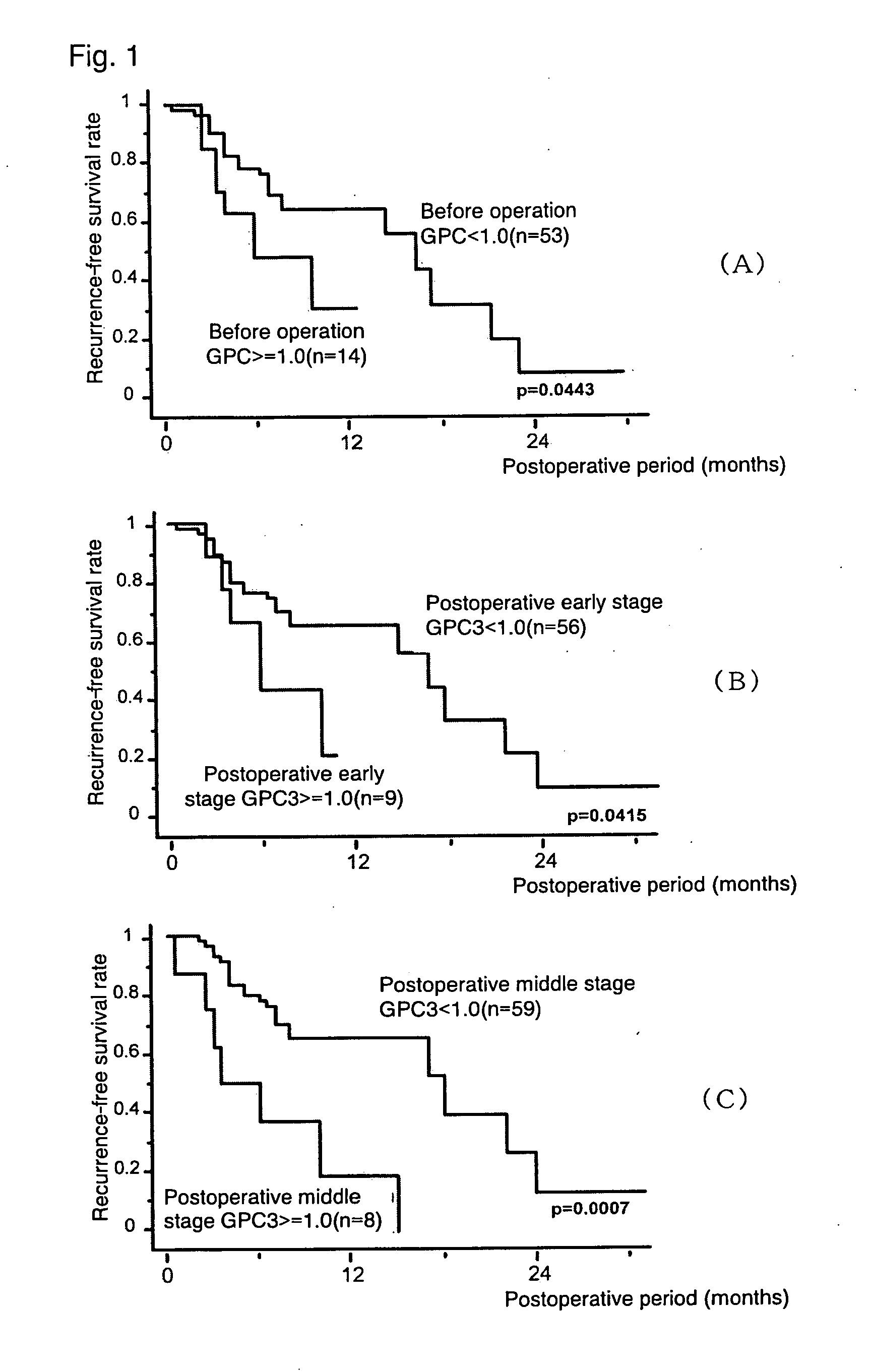Agent for Predicting and Judging the Recurrence After Treating Liver Cancer
a liver cancer and agent technology, applied in the field of liver cancer agent for predicting and judging the recurrence after treatment, can solve the problems of poor prognosis of cancer-bearing patients, tumor marker is often false-positive or false-negative, and the manner in which gpc3 level changes after liver cancer treatment has never been known
- Summary
- Abstract
- Description
- Claims
- Application Information
AI Technical Summary
Benefits of technology
Problems solved by technology
Method used
Image
Examples
example 1
Preparation of Soluble Recombinant GPC3
[0090]By use of plasmid DNA containing full-length human GPC3 cDNA, plasmid DNA which expresses flag tagged soluble GPC3 (i.e., recombinant GPC3 cDNA) was constructed. PCR was performed by use of a downstream primer (5′-ATAGAATTCCACCATGGCCGGGACCGTGCGC-3′ (SEQ ID NO: 1)) designed to eliminate a hydrophobic region (564 to 580 amino acids) on the C-terminal side, and an upstream primer (5′-ATAGGATCCCTTCAGCGGGGAATGAACGTTC-3′ (SEQ ID NO: 2)) provided with an EcoRI recognition sequence and a Kozak sequence. The resultant PCR fragment (1,711 bp) was cloned into pCXND2-Flag. The thus-prepared expression plasmid DNA was introduced into a CHO cell DXB11 line, followed by selection with Geneticin (500 μg / mL), to thereby yield a CHO line which highly expresses soluble GPC3.
[0091]Mass-culturing of the CHO cell line which highly expresses flag tagged soluble GPC3 was performed by means of a roller bottle of 1,700 cm2, and then the resultant culture supernat...
example 2
Preparation of Soluble Natural GPC3
[0092]HuH6 cell (hepatoblastoma-derived cell line), which serves as a soluble-GPC3-producing cell, was purchased from Riken Cell Bank, and was cultured in 10% FBS / Dulbecco's Modified Eagle Medium (DMEM) (SIGMA CAT# D6429) / penicillin-streptomycin (GIBCO BRL CAT# 15140-122). Specifically, the HuH6 cell was mass-cultured by means of a dish with a diameter of 150 mm, and the resultant culture supernatant was collected and purified. The culture supernatant was applied to DEAE Sepharose Fast Flow (Amersham, CAT# 17-0709-01) and then washed, followed by elution with a buffer containing 500 mM NaCl. Subsequently, concentration was performed by means of Centriprep-10 (Millipore, CAT# 4304), followed by purification through gel filtration by means of Superdex 200 HR 10 / 30 (Amersham, CAT# 17-1088-01), to thereby yield roughly purified natural GPC3.
[0093]Highly pure natural GPC3 was prepared as follows. An affinity column was prepared by use of an anti-mouse ...
example 3
Preparation of Anti-Soluble-GPC3 Polyclonal Antibody
[0094]A guinea pig polyclonal antibody was prepared by use of the soluble recombinant GPC3 or the soluble natural GPC3. The polyclonal antibody was prepared through a known method. Specifically, the GPC3 was emulsified with an adjuvant, and the resultant emulsion was subcutaneously administered for immunization. This immunization was repeated several times. After an increase in antibody titer was confirmed, blood was collected, and serum was obtained, followed by ammonium sulfate precipitation, to thereby yield the polyclonal antibody.
PUM
| Property | Measurement | Unit |
|---|---|---|
| Time | aaaaa | aaaaa |
| Time | aaaaa | aaaaa |
| Time | aaaaa | aaaaa |
Abstract
Description
Claims
Application Information
 Login to View More
Login to View More - R&D
- Intellectual Property
- Life Sciences
- Materials
- Tech Scout
- Unparalleled Data Quality
- Higher Quality Content
- 60% Fewer Hallucinations
Browse by: Latest US Patents, China's latest patents, Technical Efficacy Thesaurus, Application Domain, Technology Topic, Popular Technical Reports.
© 2025 PatSnap. All rights reserved.Legal|Privacy policy|Modern Slavery Act Transparency Statement|Sitemap|About US| Contact US: help@patsnap.com


